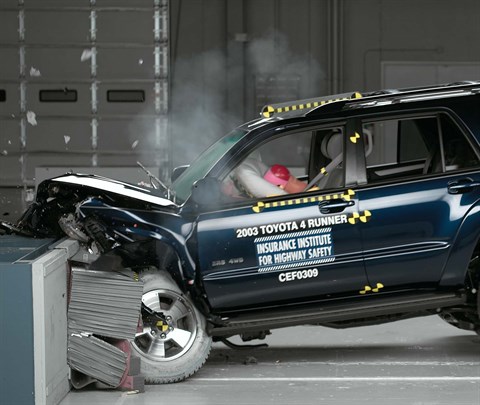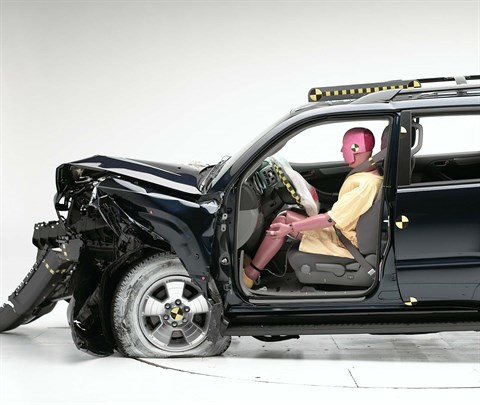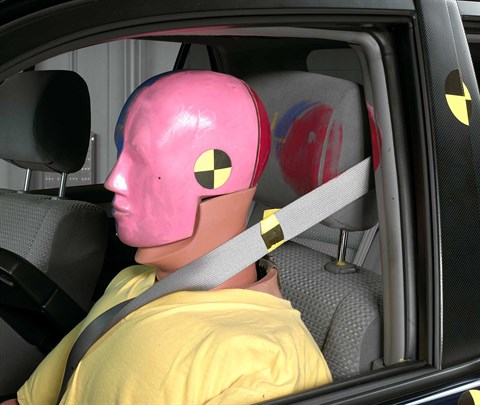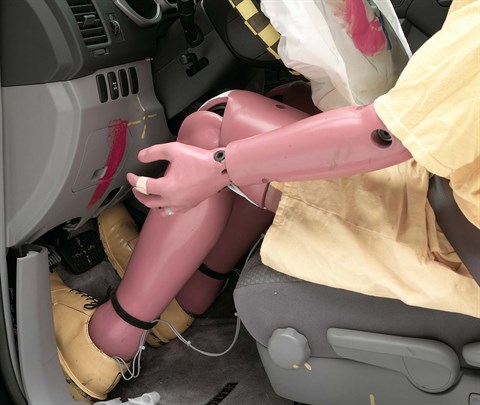Moderate overlap front: original test
Rating applies to 2003-09 models
Tested vehicle: 2003 Toyota 4Runner SR5 4-door 4wd
The Toyota 4Runner was redesigned for the 2003 model year.
| Evaluation criteria | Rating |
|---|---|
| Overall evaluation | |
| Structure and safety cage | |
| Driver injury measures | |
| Head/neck | |
| Chest | |
| Leg/foot, left | |
| Leg/foot, right | |
| Driver restraints and dummy kinematics | |

Action shot taken during the frontal offset crash test

The dummy's position in relation to the steering wheel and instrument panel after the crash test indicates that the driver's survival space was maintained well.

Smeared greasepaint indicates where the dummy's head hit the B-pillar and head restraint during rebound. Head acceleration from this hit was low.

There was little change in the position of the dummy's feet following the crash test. Injury risk was low.
Measures of occupant compartment intrusion on driver side
| Evaluation criteria | Measurement |
|---|---|
| Test ID | CEF0309 |
| Footwell intrusion | |
| Footrest (cm) | 8 |
| Left (cm) | 9 |
| Center (cm) | 15 |
| Right (cm) | 11 |
| Brake pedal (cm) | 3 |
| Instrument panel rearward movement | |
| Left (cm) | 1 |
| Right (cm) | 1 |
| Steering column movement | |
| Upward (cm) | 1 |
| Rearward (cm) | -2 |
| A-pillar rearward movement (cm) | 1 |
Driver injury measures
| Evaluation criteria | Measurement |
|---|---|
| Test ID | CEF0309 |
| Head | |
| HIC-15 | 216 |
| Peak gs at hard contact | 49 |
| Neck | |
| Tension (kN) | 1.3 |
| Extension bending moment (Nm) | 44 |
| Maximum Nij | 0.37 |
| Chest maximum compression (mm) | 36 |
| Legs | |
| Femur force - left (kN) | 0.2 |
| Femur force - right (kN) | 1.4 |
| Knee displacement - left (mm) | 1 |
| Knee displacement - right (mm) | 1 |
| Maximum tibia index - left | 0.31 |
| Maximum tibia index - right | 0.33 |
| Tibia axial force - left (kN) | 2.6 |
| Tibia axial force - right (kN) | 1.9 |
| Foot acceleration (g) | |
| Left | 61 |
| Right | 55 |
Head restraints & seats
Seat type: All seats
| Overall evaluation | |
|---|---|
| Dynamic rating | |
| Seat/head restraint geometry |
| Seat type | All seats |
|---|---|
| Geometry | |
| Backset (mm) | 38 |
| Distance below top of head (mm) | 62 |
| Seat design parameters | |
| Pass/fail | Fail |
| Max T1 acceleration (g) | 12.5 |
| Head contact time (ms) | 93 |
| Force rating | 3 |
| Neck forces | |
| Max neck shear force (N) | 96 |
| Max neck tension (N) | 1,335 |
About the head restraint & seat test
Currently, IIHS tests apply only to front seats.
